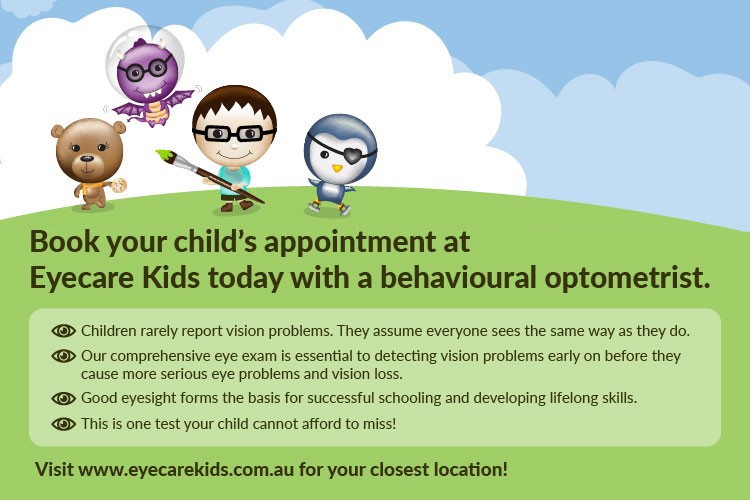Like most nine-year-old boys, Greenacre resident, Jackson loves playing sport and running around with his friends – things that have been made so much easier now that he no longer has to worry about seeing clearly.
“I was thrilled to discover all Jackson needed was eye exercises to rid himself of wearing glasses”, commented Michael, Jackson’s dad. “I never expected that to happen. I thought he would always need glasses. He responded to the treatment faster and better than I ever imagined. It is so great to see him reading a book without his eyes turning.”
Jackson was diagnosed with alternating esotropia and mild amblyopia, in other words, his eyes turned in and he experienced double vision, blurry vision and he suffered headaches.
Jackson underwent vision therapy, completing eye focusing and fusion training for half an hour each morning and had vision therapy, at Eyecare Plus Chullora once a week. Behavioural Optometrist, Dr Ali Khalife explained: “Jackson’s eye turned in and switched off which meant he was only ever using one eye at a time. The first goal was to switch his eye back on with anti-suppression therapy. Jackson needed to realise that he should be seeing double when his eyes were turned. Once this was achieved fusion training helped him to move the double images until they were superimposed. This not only worked to straighten his eyes, it created binocularity and good depth perception. Jackson responded so well to the therapy that he no longer requires glasses to make his eyes straight. Every patient is different and unfortunately not everyone with esotropia would be able to discard their glasses, but Jackson is a great testament to how powerful vision therapy can be.”
Jackson’s double vision decreased after a few months of vision therapy and he was able to gain full control of his eye posture over time. “I was happy that eye exercises made my eyes better, and that I do not have to wear glasses anymore. Now I can read a book without crossing my eyes, and I can see clearly”, exclaimed Jackson.
Michael added “Jackson can now feel and control the turning of his eyes. He no longer needs to wear glasses in order to see in the classroom. Practically speaking, it has made his days at school easier without having to deal with glasses, and socially easier as he is no longer teased for wearing them. He can both play sport and read without the aid of glasses.
“It has given Jackson more confidence in himself and improved his self-esteem. It has greatly relieved his mother and I in discovering that all Jackson needed was some training with the use of eye exercises to conquer his chronic eye-turning, without having to resort to wearing eye patches or surgery.”
Undetected vision problems are estimated to affect approximately one in four Australian children – or 600,000 nationally – which may contribute to potential learning difficulties in reading, writing, viewing a whiteboard, computer use and other classroom activities. A review undertaken as part of the National Children’s Vision Screening Project reported most children with academic or behavioural problems fail one or more visual tests.
Dr Ali Khalife commented, “Vision therapy can help children with tracking, focusing and teaming problems as well as lazy and turned eye which are common visual problems in children. It involves teaching the patient to consciously become aware of how they are using their eyes through a series of therapy activities which we have available at our practices. It’s a little like teaching someone how to ride a bike or learn how to play the piano, we teach them to learn how to use their eyes more efficiently. We have designed our practices around the needs of children ensuring each consultation can be completed in a fun, interactive and educational way for children from two years old.”
Dr Ali Khalife adds, “Vision therapy isn’t suitable for everyone so we encourage parents to speak to one of our vision experts. Our optometrists can provide a full eye exam and suggest the best course of management for the child’s eye condition.”
Optometrists Association Australia recommends that children have a full eye examination with an optometrist before starting school and at least every two years thereafter. Eye examinations usually attract a Medicare rebate and no referral is required. Vision therapy may attract health insurance benefits.

